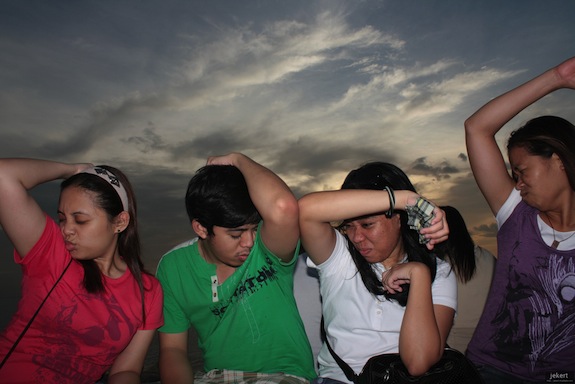We Can Only Process Thirty Smells at a Time
If we had the technology, I would be blowing smells at you right now. But if I were to try and combine more than thirty, you wouldn’t be able to tell the smells apart

Image: jekert gwapo
If the technology existed, right now, this blog post would be blowing smells at you. But if it were to try and combine more than thirty, you wouldn’t be able to tell the smells apart. Science Now explains:
In the tests, volunteers sniffed a mixture and then compared it with other mixtures made up of varying numbers of odorants. When the test mixture had just a few components, volunteers could easily distinguish it from the other blends, Sobel says. But as the number of odorants in a mixture rose above 20, volunteers began to perceive the blends as becoming more and more similar. By the time mixtures contained 30 or more components, most of the blends were judged to smell alike, the researchers report online today in the Proceedings of the National Academy of Sciences. The team dubbed the generic scent associated with large mixtures “olfactory white.”
“White smell”—like “white noise”—is probably rarely found in nature but will help researchers understand far better how people smell and how the brain interprets odors. And, of course, it will be useful to the future purveyors of Smell-O-Vision.
Smell-O-Vision actually was a reality at one point. But the technology was crude—usually made up of a fan blowing over something smelly to push smells into a theater—and it lingered on the seats and on people’s clothes. Scientific American explains:
Shortly after the first (and last) release of a Smell-O-Vision movie, Scent of Mystery,where the murderer was revealed by the smell of his pipe tobacco, other engineers experimented with more individualized immersive media experiences. TheSensorama was Morton Heilig’s vision of the “cinema of the future,” showing a film of a ride on a motorbike with a vibrating and tilting seat, fans blowing wind in the viewer’s face, and the aroma of flowers or baking pizza as the rider passes a garden or an Italian restaurant. However, like Smell-O-Vision before it, Sensorama failed to attract funding and is now merely a mechanical curiosity in the early history of virtual reality.
SciAm turned up a few patents for things that will help us smell our virtual reality, like this one from 1997 and this one from 2004. The difficulty with Smell-O-Vision as it currently stands is that it’s hard to generate the smells we encounter in real life in a convincing way and then deliver them on demand.
Even our words for smell are strange. Scienceline writes:
Try to describe a smell without referring to its source. What does garlic smell like aside from garlic? What does a pineapple smell like aside from pineapple? What does morning breath smell like aside from…well, morning breath?
For garlic, you might’ve said savory. For pineapple, sweet. For morning breath, ugh, who knows – hot, acrid, pungent, sharp, complex, like regret…
The thing is, we lack a basic smell vocabulary — there is no smell equivalent of blue or red. So when we describe smells, we most often just name the source: pineapple smells like pineapple. Sometimes we co-opt a term from one of our other senses, like sweet and savory from taste or sharp and hot from touch. And if we’re feeling especially uninspired, we simply evaluate the smell’s quality or intensity or both: it’s an offensive smell, a strong smell, a faint smell, a pleasant smell, or a pungent smell (which is both offensive and strong).
So those thirty scents we can handle, we couldn’t describe the vast majority of them with words, either.
More from Smithsonian.com:
What Does Home Smell Like?
How Advertisers Convinced Americans They Smelled Bad
/https://tf-cmsv2-smithsonianmag-media.s3.amazonaws.com/accounts/headshot/Rose-Eveleth-240.jpg)
/https://tf-cmsv2-smithsonianmag-media.s3.amazonaws.com/accounts/headshot/Rose-Eveleth-240.jpg)